Abstract
This paper presents the design of a miniaturized polyimide-based antenna for ultra-wideband (UWB) communication. Miniaturization is achieved through the utilization of adhesive material with a high dielectric constant (high-Dk). The goal of this work is to investigate the impact of such material on the antenna performance and to optimize its design for UWB operation. The manufacturing of the antenna using the proposed structure is developed, and the prototype of an antenna for the UWB high band (6–9 GHz) is measured and analyzed. By leveraging the high Dk of the adhesive material, the simulation and measurement results show that the proposed antenna with a high-Dk adhesive film can achieve compact dimensions with good performance in terms of the gain and time domain characteristics. The results of this study show the potential of exhibiting a reduction in the size of the antenna and will contribute to the advancement of miniaturized UWB antenna technology.
1. Introduction
Ultra-wideband (UWB) technology has increasingly aroused a lot of interest in many applications of high-speed wireless communication and accurate localization [1,2]. With the characteristic of wide bandwidth, UWB systems have the advantages of improvement in multi-path fading immunity, enhancement in ranging resolution, great objective penetration ability, and high tolerance to interference with other wireless systems [2].
According to the Federal Communications Commission (FCC), UWB signals are characterized by having an absolute bandwidth of over 500 MHz or a relative bandwidth of more than 20% [3]. The FCC played a pioneering role in setting the standards for the application of UWB technology in the United States. Subsequently, other regions such as Europe, Japan, Korea, and other countries followed, developing their own set of regulations for UWB standards [4]. In Europe, Korea, and Japan, the bandwidth of UWB communication is categorized into two bands: the low band and the high band. However, to use the low band of UWB (ranging from 3.1 to 4.8 GHz in Europe), a license is required for implementation [5]. On the other hand, the high band of UWB (ranging from 6 to 8.5 GHz in Europe) does not require a license, facilitating a more rapid introduction of systems. As a result, there has been a recent surge in demand for the development of high-band UWB antennas.
In the antenna design process for UWB systems, miniaturization is a challenge due to the physical size constraints imposed by their applications. In [6,7], the Vivaldi structure was proposed for UWB applications, given its remarkable features such as high gain, fairly wide bandwidth, and a directive radiation pattern. However, their larger physical size poses a challenge when integrating them into devices with size limitations. Alternatively, the monopole structure is another promising approach for UWB antennas due to its simplicity in design, cost-effectiveness, ease of fabrication, and the ability to achieve omni-directional radiation patterns [8,9,10]. In [11,12], planar monopole antennas utilizing an FR4 substrate were suggested. However, PCB antennas with common substrates like FR4 or Rogers often have a thick profile, which may not be suitable for compact designs [13,14]. To address the issue of antenna miniaturization, one solution involves utilizing thin film technology. By combining the advantages of the monopole antenna design with a thin film structure, several approaches have been reported to overcome the size limitations of the antennas.
In [15], a tapered slot antenna using a 200 μm liquid crystal polymer (LCP) substrate was proposed. The design showed great radiation performance and excellent time domain characteristics as very little distortion was introduced by the antenna. However, the bulky dimensions ( mm) are not suitable for modern electronics integration. In [16], an elliptically shaped monopole UWB antenna printed on Kapton polyimide substrate was presented. It showed good radiation characteristics and impedance matching, with low degradation when under bending effects. However, the size of it ( mm) needs further miniaturization.
In [17], H. Bahrami et al. designed flexible spiral-type dual-polarization antennas for neural recording systems by using a substrate of polyimide (PI) with a dielectric constant (Dk) of 3.5. In [18], a CPW-fed monopole with dimensions of mm for wearable application was suggested. Polyester with Dk = 3.2 was used as an antenna substrate, and polydimethylsiloxane (PDMS) with Dk = 2.3–2.8 was used as an artificial magnetic conductor (AMC). In [19], Hong et al. proposed a design of a transparent and flexible antenna with an ITO/Ag/ITO (IAI) multilayer for wearable glasses application. A PI film layer with Dk = 3.5 was chosen as the substrate. Phan et al. designed a microstrip monopole antenna “Sapin” covering the bandwidth from 2.2 to 10 GHz for wireless local area network (WLAN) application [20]. The antenna’s dimensions were mm, and the substrate was E4D paper with Dk = 3.184. Among all these works, low-Dk film materials were often chosen as the antenna’s substrate because low-Dk material allows energy to be radiated out of the system rather than being stored in the substrate, which results in increasing the bandwidth of resonance. However, to overcome the space limitation, one approach to miniaturization is to use a high-Dk substrate with bandwidth scaling.
Film material, however, usually has a low Dk. In the structure of a thin-film antenna, the thickness of the bonding adhesive layer is comparable with the PI layer. Therefore, its impact can be significant to the antenna’s performance. Current technologies are focusing on making low-dielectric constant (low-Dk) and low-dielectric dissipation (low-Df) adhesive bonding film for utilizing the resonant bandwidth. However, the dimensions of an antenna are inversely proportional to the Dk of the substrate. Therefore, using a high-Dk adhesive can be one potential solution to achieving miniaturization of the antenna. To the best of the authors’ knowledge, none of the existing research has investigated the effect of the adhesive layer on the performance of the antenna. Hence, for the first time, the utilization of a high-Dk bonding adhesive in the design and construction of the antenna is explored. In this work, we use a new adhesive material with a high Dk and low Df as the bonding sheet to propose an antenna with a thin-film structure. By investigating the overall performance, valuable insights can be acquired to study the efficiency and potential of using a high-Dk adhesive for thin-film antennas. Aside from the physical size constraint, other parameters must also be considered in the designing process of UWB antennas, such as a wide bandwidth, stable pattern characteristics, and good time domain performance [21].
In this paper, we propose a design of an antenna for UWB applications using a new adhesive material with a high Dk and low Df. Our investigation showcases the potential of utilizing such material to reduce the antenna’s overall size while maintaining the desired UWB characteristics. First, the antenna design of an antenna for the high band of UWB (6–9 GHz) application using a high-Dk, low-Df bonding sheet adhesive will be formulated in Section 2. The details of the design and parametric studies of important parameters will be presented. Next, the antenna fabrication and experimental results, including the radiation pattern, reflection coefficient, and gain, are simulated and measured in Section 3. In Section 4, the time domain analysis is presented. In Section 5, the approach to achieve a small-sized antenna by using a high-Dk adhesive is verified through experimentation. Discussion and comparison with other existing film-based antennas will be presented, and the final conclusion is stated in Section 6.
2. Design of Thin-Film UWB Monopole Antennas
2.1. Thin-Film Layer Stack Up
The target operation frequency range of the proposed thin-film UWB antenna is 6–9 GHz, which is the UWB high band for indoor UWB transmissions when no mitigation techniques are used [5]. Among a variety of UWB antenna structures, a bell-shaped monopole antenna, shown in Figure 1, was chosen since this structure is compatible with thin films and offers broadband impedance matching and omnidirectional radiations [22,23,24]. The stack up of the thin film is also depicted in Figure 1. It consisted of top and bottom copper layers deposited on PI layers. This paired copper/PI layer was bonded together by the middle adhesive layer, which exhibited a high Dk property in this proposed design. The Dk and Df of the PI layer were 3.3 and 0.005, respectively, while the Dk and Df of the adhesive layer were 6 and 0.006, respectively. The thicknesses of the copper, PI, and adhesive layers were 12 m, 50 m, and 50 m, respectively. The total thickness of the antenna combination was 174 m. It is worth noting that the thickness of one layer of copper and adhesive was the same, while the Dk of the adhesive layer was 1.8 times higher than that of the PI layer. Thus, the high Dk property of the adhesive layer was supposed to promote thin-film antenna miniaturization, similar to previous reports on PCB antenna miniaturization using high-Dk substrates [25,26,27]. By employing the PI film layer as the substrate, the proposed antenna inherits the advantages of the PI film, including excellent electrical performance, high thermal stability, and resistance to environmental factors [28], making them a compelling choice for creating compact UWB antennas.
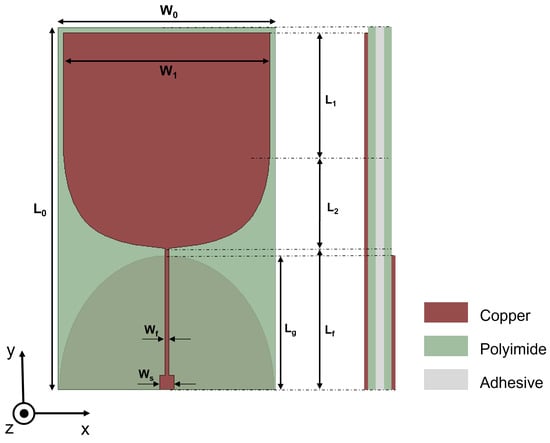
Figure 1.
Geometry of the proposed thin-film UWB monopole antenna.
The adhesive used in this study was provided by APC Inc. (Seoul, Republic of Korea). This adhesive is composed of a polyolefin base material, the properties of which, such as the elasticity and plasticity, can be finely tuned through adjustments to its density. To enhance the thermal resistance of the resin, a cross-linking agent and catalyst were introduced to the polyolefin matrix. Initially, the adhesive resin exhibited a Dk value of merely 1.9. In order to elevate the Dk of the adhesive, a novel approach was taken. A ferroelectric material powder was incorporated into the adhesive formulation. Subsequently, the mixture underwent a heating process within a Pb bath at a temperature of 265 °C for 10 s intervals, and this was repeated multiple times. This intricate procedure led to a substantial increase in the Dk value, ultimately reaching six. Notably, this procedure proved to be effective at mitigating issues related to problematic pores and undesirable uplifting phenomena, thereby enhancing the overall adhesive performance.
2.2. Simulation Results
Figure 1 shows the geometry of the proposed printed monopole antenna backed by a partial ground plane, where and are the width and length of the antenna, respectively. The dimensions of the proposed antenna were mm. The ground of the antenna was designed based on a half-elliptical shape with a vertex length of , and is the aspect ratio of the ellipse, which is the ratio between the length of the major axis and the minor axis. The radiator patch was determined by the width , and the length of the patch is a combination of a straight line with a length and a curve which was drawn by using the spline function. and are the length and width of the transmission line, respectively. A small rectangle with a width was placed at the starting point of the feed line for soldering with a SubMiniature version A (SMA) connector. Table 1 shows the list of these parameters and their optimized values.

Table 1.
Optimized parameters of proposed high-band antenna.
Figure 2 presents the simulation results of of the antenna while changing some key parameters in the designing process. Here, refers to the reflection coefficient of the antenna and indicates the amount of power that was reflected back toward the source when an electromagnetic signal was transmitted through the antenna. To improve the impedance and radiation properties, a partial ground was designed. The effects of the length were analyzed, and they are shown in Figure 2a. As we can see, the smaller ground plane’s length would result in poor impedance matching results, and with the longer ground plane’s length, the resonant frequency would shift to a lower frequency. It is worth noting that the increase in the ground plane’s length would result in a smaller gap between the antenna’s patch and the ground. With being 7.7 mm, this gap was so small that the bandwidth became narrower. Only the ground length of 7.3 mm met the required < −10 dB over an interested frequency bandwidth of 6–9 GHz. Hence, 7.3 mm was chosen as the value of .
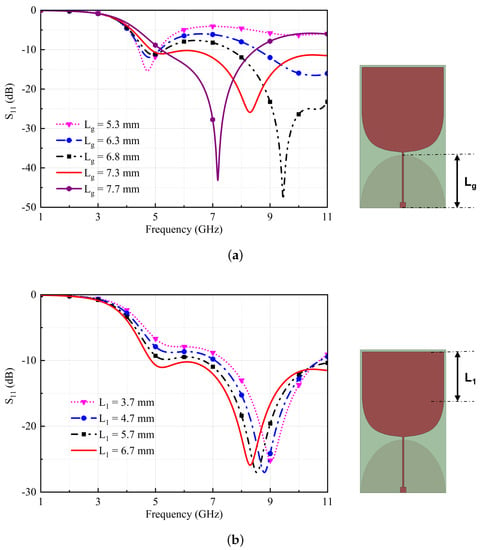
Figure 2.
Simulation results of versus frequency by varying (a) and (b) .
Figure 2b shows how the length of the straight patch influenced the magnitude of the reflection coefficient over various frequencies. As can be seen, when the patch became longer, the resonant frequency tended to move toward the lower band. This can be explained by the longer patch length resulting in a longer electrical length, and the propagation occurred in a longer wavelength, indicating a lower resonant frequency. Moreover, the > −10 dB around the mid-band of the UWB is recorded in shorter patch length. On the other hand, with being 6.7 mm, a good < −10 dB was provided for our interested frequency band of 6–9 GHz. For this reason, the appropriated value was chosen to be 6.7 mm. To verify the theoretical results, the following section will address this with experiments.
3. Antenna Fabrication and Measurements
A photograph of the fabricated antenna with the front and back view is shown in Figure 3. For experimental measurements, our antenna required connection to a vector network analyzer (VNA) via a connector. The model of the used VNA was MS46122B, which is a part of ShockLine family from Anritsu. It offers a frequency measurement range spanning from 1 MHz to 43.5 GHz. The part number of the SMA connector used was Board Edge SMA SM06FS006 of the Withwave company. This connector operates within a frequency range from 10 MHz to 26.5 GHz, ensuring matching of 50 . Because the proposed antenna has compact dimensions, and the size of the SMA connector is comparable to the antenna’s size, the widened ground effect on the antenna is very significant. To address these problems, the one-port de-embedding technique [29] was applied to remove the connector’s effect on the proposed antenna. Figure 4 shows the comparison of ’s results between the simulation and experiment after the de-embedding process. We can notice some agreements in the reflection coefficient between the simulation results and the experiment results post de-embedding. However, certain discrepancies still persisted between them. These differences could potentially be from insertion loss of the cable connected between the VNA and the antenna or the impact of soldering. It is noteworthy that both the simulation and experimental results exhibited a bandwidth exceeding 6–9 GHz for < −10 dB, effectively satisfying our targeted frequency band for the high band of the UWB. The experimental impedance bandwidth was recorded in the range of 5–10.8 GHz.
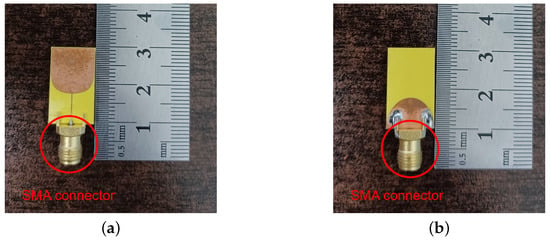
Figure 3.
Fabricated antenna prototype with an SMA connector. (a) Front view. (b) Back view.
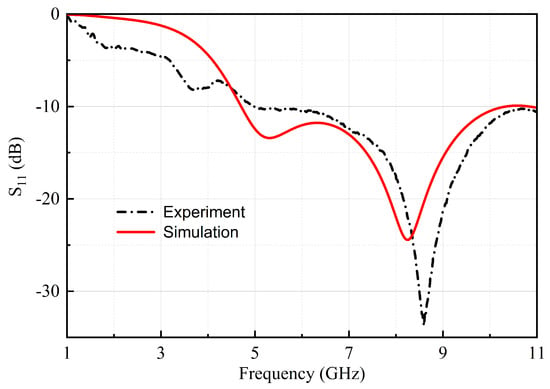
Figure 4.
Comparison of ’s simulation and experiment results.
For the far-field gain experiment, the antenna measurement was performed in an anechoic chamber. Figure 5 shows a picture of the fabricated antenna in the chamber while taking measurements. Figure 6 shows a comparison between the simulation and measurement results of the designed antenna operating at 6 GHz and 7.5 GHz, in terms of normalized radiation patterns in the H plane (or XY plane) with = 90 and the E plane (or XZ plane) with = 0. Apparently, an omnidirectional radiation pattern in the E plane (XZ plane) and a form in a figure-eight shape in the H plane (XY plane) were provided. There are some discrepancies between the measurement and simulation results, which could arise from various sources, including the effects from the SMA connector and cable, the potential fabrication errors in the antenna itself, or the impact of soldering related to the SMA connector.
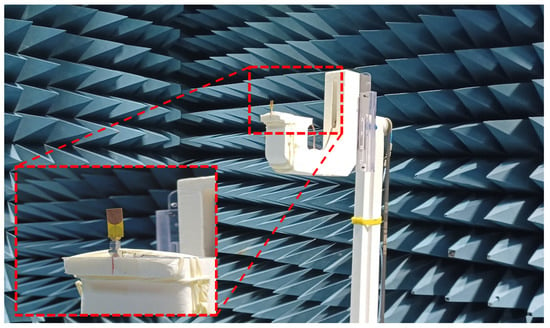
Figure 5.
The fabricated antenna located in the anechoic chamber.
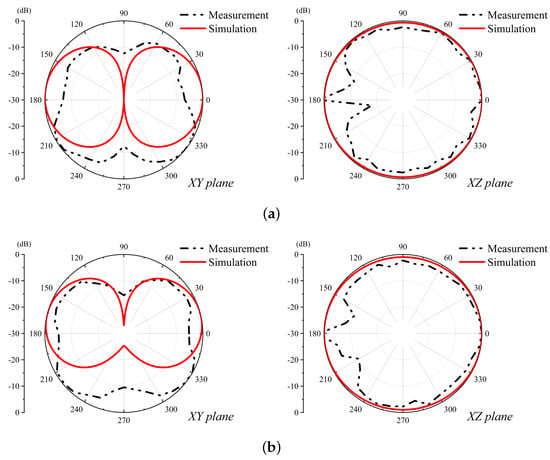
Figure 6.
Comparison of simulated and measured normalized radiation patterns at (a) 6 GHz and (b) 7.5 GHz.
Figure 7 shows the peak gain of the fabricated antenna in the simulation and experiment in the XZ plane ( = 0). The measured gain had a highly similar trend to the simulated gain. However, it was lower than that in the simulation, which can be explained by the loss of the cable, the connector, and the chamber not being calibrated effectively. The average measured peak gain was about 2.1 dB over the frequency band, and the maximum peak gain of 2.8 dB was measured at 8 GHz, while it was 3.6 dB in the simulation. The antenna gain was acceptable for an omnidirectional radiated antenna. The measurement results in the time domain of the proposed antenna will be discussed in the following section.
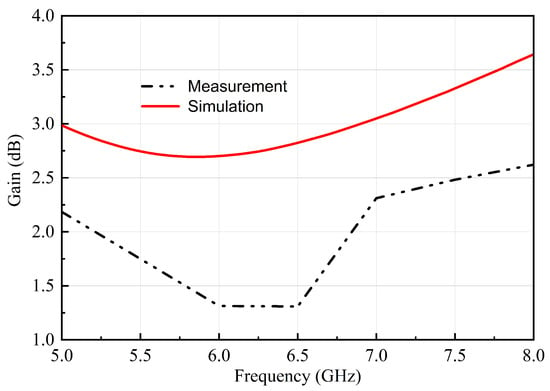
Figure 7.
Comparison of peak realized gain measurement and simulation at = 90.
4. Time Domain Analysis
This section will analyze the pulse shape preservation capabilities of the antenna. In the ideal case, the received UWB pulse should have the same shape as the transmitted pulse. Therefore, the antenna design process should consider this to minimize the distortion effects produced by the antenna itself and the environment.
To analyze the time domain performance, the common approach is to consider the antenna as a linear time-invariant (LTI) system described by its transfer function or transmission parameter [30,31,32]. The measurement with a VNA was executed inside an anechoic chamber. For setting up the time domain analysis, the two identical prototypes of the proposed antenna were positioned at a distance of 100 mm apart from each other. Figure 8 shows three distinct configurations for time domain measurement: side by side, face to face, and face to side. The time domain measurement arrangement is depicted in Figure 9. Two identical prototypes of the proposed antenna were located in the chamber, maintaining the distance of 100 mm between them and simultaneously connected to a VNA. Notably, the same VNA model used for the measurement, which was the ShockLine Anritsu MS46122B, was also employed for the time domain analysis.
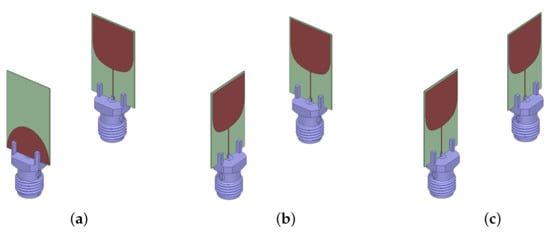
Figure 8.
Time domain measurement configurations: (a) face to face, (b) face to side, and (c) side by side.
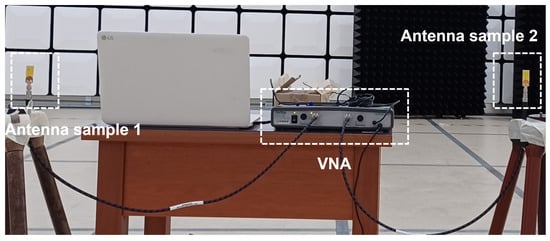
Figure 9.
Time domain measurement set up.
The system transfer functions of the antenna systems of two identical antennas will be presented and analyzed. In order to transmit pulses without any distortion, the system transfer function should be constant over the desired frequency. By plotting both the phase and magnitude of , we can quantify the pulse distortion effects based on their linearity characteristics. Figure 10 shows the measured magnitude and phase results of for three configurations. It can be observed that the magnitude was quite stable, and the phase response was linear over the frequency range of 6–9 GHz, which signifies that the pulse shape was preserved without any out-of-phase components.
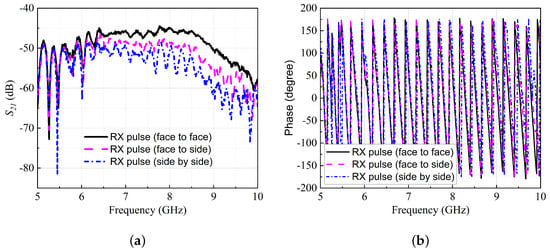
Figure 10.
Measured of three configurations (a) in dB versus frequency. (b) phase variation.
For analyzing the pulse shape preservation capability of the antennas, the square root raised cosine signal (SRRC) pulse was chosen as the input pulse for its bell-shaped energy distribution across the frequency range [33]. The mathematical form of the SRRC pulse is shown in Equation (1):
where is the roll-off factor for bandwidth control, t is the time, and = 1/, in which is the symbol rate.
Figure 11 shows the amplitude-modulated SRRC pulse and its power spectrum density corresponding with the UWB indoor spectrum mask. The roll-off factor and the symbol rate of the modulated SRRC pulse were 0.4 and 10 GHz, respectively. The chosen center frequency of the input pulse was 7.5 GHz, with the bandwidth covering the high band of the UWB (6–9 GHz).
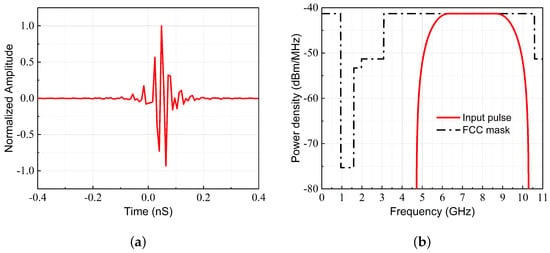
Figure 11.
Simulated input-modulated SRRC pulse. (a) Normalized input-modulated SRRC pulse. (b) Power spectral density of modulated SRRC pulse.
Figure 12 represents the pulse shape comparison of the modulated SRRC input pulse and received pulses in three configurations. The received signals were calculated by multiplying the original input signal with the transfer function in the frequency domain and then applying an inverse Fourier transform to return them to the time domain. The received signals in the three configurations were almost identical, showing the consistency of the pulse preservation capability of the proposed antennas in the omnidirectional plane of the antennas.
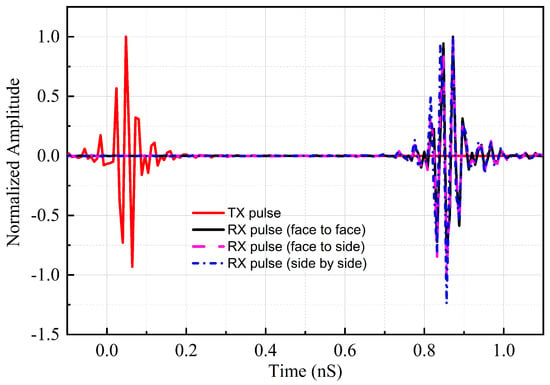
Figure 12.
Simulated normalized amplitude of input and received signal pulse.
To further investigate the equivalence between the transmitted and received waveform, the fidelity factor can be calculated as shown in Equation (2):
where and are two signals to be compared. The fidelity factor is found by taking the cross-correlation between two normalized signals when they are overlapped [34,35]. A fidelity factor of one means that the transmitted pulse and the received pulse are identical, and there was no distortion during transmission. On the other hand, the fidelity factor tending toward zero shows that the two signals are completely different. Table 2 shows the fidelity factors of the antennas in three configurations. The results show that the fidelity was greater than 0.85, validating that the proposed antenna did not distort the signal pulse significantly.

Table 2.
Fidelity factor of three configurations.
The group delay shows the time delay of specific frequency components when traveling through a device. If the signal only contains one frequency component, which is a perfect sine wave, then the whole signal will experience a stable group delay. The UWB signal, however, consists of numerous frequency components. In order to avoid being delayed differently at different frequencies, a linear phase response is required. This means a stable group delay over a frequency is mandatory in UWB systems to satisfy the ideal case of the pulse reservation condition [36].
In simple terms, the group delay is the rate of change of the phase shift with respect to the frequency. This delay can be expressed mathematically as the negative derivative of the phase response with respect to the frequency :
The measured group delay is presented in Figure 13. We can recognize a quite stable group delay in the three configurations at the desired frequency band. Hence, the proposed antenna was determined to be suitable for UWB communications.
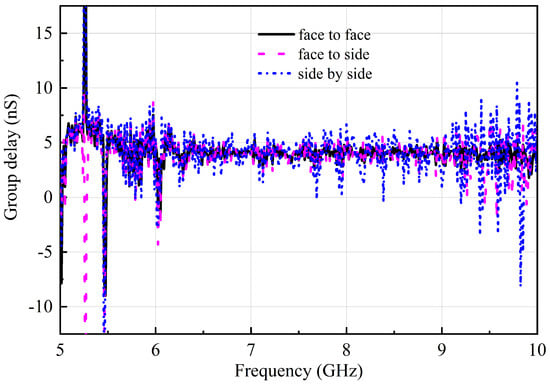
Figure 13.
Measured group delay of three configurations.
5. Effect of the Adhesive Layer Material
In the upcoming section, we will verify the proposed method of miniaturization through experimental analysis. Our focus will be investigating how changing the dielectric constant of the adhesive layer in the antenna design can impact the antenna’s performance and its dimensions. By systematically evaluating different dielectric constants and their effects, we can gain insights into the process of achieving compact antennas. Additionally, this examination underscores the benefits that high-dielectric constant (high-Dk) materials bring to the forefront of antenna miniaturization and efficiency enhancement.
Introducing a modification, we replaced the high-Dk adhesive (Dk = 6) with a low-Dk adhesive (Dk = 2) while keeping all other parameters of the proposed antenna unchanged, resulting in the fabrication of an alternative antenna. The picture of this newly created antenna employing the low-Dk adhesive is depicted in Figure 14a, while Figure 14b shows the proposed antenna prototype employing the high-Dk adhesive.
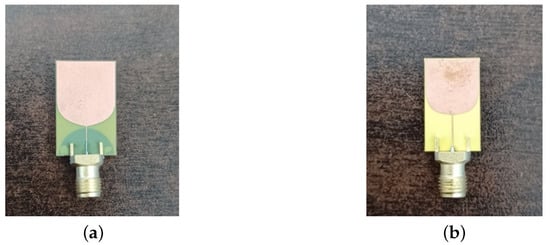
Figure 14.
Fabricated antenna (a) using low-Dk adhesive, (b) using high-Dk adhesive.
Figure 15 provides a comparison of the measurement results for both antennas, with one utilizing the high-Dk adhesive and the other utilizing the low-Dk adhesive. As can be seen, using the low-Dk adhesive had the advantage of bandwidth enhancement. On the other hand, opting for a higher-Dk adhesive could prompt a resonant frequency shift to the lower band, transitioning from 8.9 GHz to 8.5 GHz with the cost of bandwidth reduction. Considering that the antenna size is proportional to the wavelength, it follows that the antenna employing the high-Dk adhesive experienced a 6% reduction in size compared with the antenna with the low-Dk adhesive. Based on the results, the utilization of a high-Dk adhesive holds significant promise for achieving a more compact antenna design, thereby corroborating the validity of our approach.
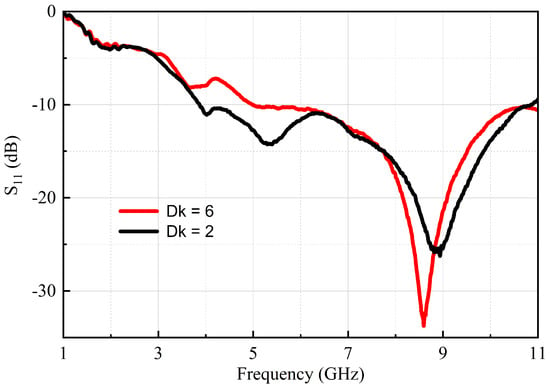
Figure 15.
Measured of proposed antennas with high-Dk and low-Dk adhesives.
6. Conclusions
A comparison between the proposed antenna and other existing film-based structure antennas is presented in Table 3. Both the absolute size and electrical size are presented, highlighting that the proposed antenna features relatively compact dimensions in comparison with other film-based antennas in the literature. The free space wavelength was chosen with respect to the lower frequency of the frequency band. Despite its remarkably thin thickness, the proposed antenna exhibited a bandwidth coverage of 5.8 GHz, spanning from 5 to 10.8 GHz and effectively meeting the requirements for the UWB high band. In terms of gain, the maximum value achieved was 2.9 dB, which is slightly lower compared with some works due to the trade-off made for achieving a smaller size. Nevertheless, this level of gain is acceptable, especially considering the omnidirectional radiation pattern characteristic of such a monopole antenna.

Table 3.
Comparison of various existing film-based antennas with the proposed antenna.
To summarize, in this paper, a miniaturized thin-film antenna using a new high-Dk adhesive material was designed and fabricated for UWB communication. The antenna features compact dimensions of mm with a thickness of 174 m and exhibited a wide impedance bandwidth covering from 5 to 10.8 GHz. The experimental results closely aligned with the simulations, demonstrating excellent agreement. As a validation of our miniaturization approach, we constructed another antenna with identical design parameters, substituting the high-Dk adhesive with a low-Dk adhesive. The results reveal that by increasing the dielectric constant of the adhesive layer from 2 to 6, the resonant frequency of the antenna successfully decreased from 8.9 GHz to 8.5 GHz, which resulted in a reduction of 6% in the size of the antenna when using the high-Dk adhesive. Additionally, the proposed antenna demonstrated favorable time domain performance. This work gained insights into achieving thin-film compact antennas by manipulating the adhesive layer’s properties.
Author Contributions
Conceptualization, D.N.D. and J.-Y.C.; methodology, D.N.D. and J.-Y.C.; software, D.N.D.; validation, D.N.D. and J.-Y.C.; formal analysis, D.N.D.; investigation, D.N.D.; resources, D.N.D.; data curation, D.N.D.; writing—original draft preparation, D.N.D.; writing—review and editing, D.N.D. and J.-Y.C.; visualization, D.N.D. and J.-Y.C.; supervision, J.-Y.C.; project administration, J.-Y.C.; funding acquisition, J.-Y.C. All authors have read and agreed to the published version of the manuscript.
Funding
This work was supported in part by the Basic Science Research Program through the National Research Foundation of Korea (NRF), funded by the Ministry of Education (NRF-2019R1A6A1A03032119), and in part by the Technology Development Program (S3238198), funded by the Ministry of SMEs and Startups (MSS, Republic of Korea).
Data Availability Statement
Not applicable.
Conflicts of Interest
The authors declare no conflict of interest.
References
- Elsanhoury, M.; Mäkelä, P.; Koljonen, J.; Välisuo, P.; Shamsuzzoha, A.; Mantere, T.; Elmusrati, M.; Kuusniemi, H. Precision Positioning for Smart Logistics Using Ultra-Wideband Technology-Based Indoor Navigation: A Review. IEEE Access 2022, 10, 44413–44445. [Google Scholar] [CrossRef]
- Zafari, F.; Gkelias, A.; Leung, K.K. A Survey of Indoor Localization Systems and Technologies. IEEE Commun. Surv. Tutor. 2019, 21, 2568–2599. [Google Scholar] [CrossRef]
- Federal Communications Commission. First report and order. In Proceedings of the Revision of Part 15 of commission’s rule regarding UWB transmission system FCC 02-48, Washington, DC, USA, 22 April 2002. [Google Scholar]
- European Telecommunications Standards Institute. Short Range Devices (SRD) Using Ultra Wide Band (UWB); Part 3: Worldwide UWB Regulations between 3.1 and 10.6 GHz TR 103 181-3; ETSI: Sophia Antipolis, France, 2016. [Google Scholar]
- Niemelä, V.; Haapola, J.; Hämäläinen, M.; Iinatti, J. An Ultra Wideband Survey: Global Regulations and Impulse Radio Research Based on Standards. IEEE Commun. Surv. Tutor. 2017, 19, 874–890. [Google Scholar] [CrossRef]
- Jeon, G.H.; Dzagbletey Philip Ayiku, C.J.Y. A Cross-Joint Vivaldi Antenna Pair for Dual-Pol and Broadband Testing Capabilities. J. Electromagn. Eng. Sci 2021, 21, 201–209. [Google Scholar] [CrossRef]
- Gorai, A.; Ghatak, R. Binomial stub loaded compact Vivaldi antenna for superwideband applications. Int. J. Microw. Wirel. Technol. 2021, 13, 463–468. [Google Scholar] [CrossRef]
- Liang, J.; Chiau, C.; Chen, X.; Parini, C. Study of a printed circular disc monopole antenna for UWB systems. IEEE Trans. Antennas Propag. 2005, 53, 3500–3504. [Google Scholar] [CrossRef]
- Zaker, R.; Ghobadi, C.; Nourinia, J. Novel Modified UWB Planar Monopole Antenna With Variable Frequency Band-Notch Function. IEEE Antennas Wirel. Propag. Lett. 2008, 7, 112–114. [Google Scholar] [CrossRef]
- Alipour, A.; Hassani, H.R. A Novel Omni-Directional UWB Monopole Antenna. IEEE Trans. Antennas Propag. 2008, 56, 3854–3857. [Google Scholar] [CrossRef]
- Mekki, K.; Necibi, O.; Lakhdhar, S.; Gharsallah, A. A UHF/UWB Monopole Antenna Design Process Integrated in an RFID Reader Board. J. Electromagn. Eng. Sci 2022, 22, 479–487. [Google Scholar] [CrossRef]
- Bala, S.; Reddy, P.S.; Mondal, R.; Sarkar, P.P.; Sarkar, S. Printed Monopole Antenna with Tree-Like Radiating Patch and Flower Vase-Shaped Modified Ground Plane Useful for Wideband Applications. J. Electromagn. Eng. Sci. 2022, 22, 256–264. [Google Scholar] [CrossRef]
- Widyatama, P.Z.; Nugroho, B.S.; Nur, L.O. Design of Circular Modified UWB Antenna Microstrip for Brain Cancer Detection. In Proceedings of the 2019 IEEE Asia Pacific Conference on Wireless and Mobile (APWiMob), Bandung, Indonesia, 28–29 November 2019; pp. 33–36. [Google Scholar]
- Prashanth, K.; Hadalgi, P.M.; Hunagund, P.V. Comparative investigation on multi-band antenna using FR-4 and RT-Duroid. Int. J. Ultra Wideband Commun. Syst. 2022, 5, 40–46. [Google Scholar] [CrossRef]
- Nikolaou, S.; Ponchak, G.; Papapolymerou, J.; Tentzeris, M. Conformal double exponentially tapered slot antenna (DETSA) on LCP for UWB applications. IEEE Trans. Antennas Propag. 2006, 54, 1663–1669. [Google Scholar] [CrossRef]
- Khaleel, H.R.; Al-Rizzo, H.M.; Rucker, D.G.; Mohan, S. A compact polyimide-based UWB antenna for flexible electronics. IEEE Antennas Wirel. Propag. Lett. 2012, 11, 564–567. [Google Scholar] [CrossRef]
- Bahrami, H.; Mirbozorgi, S.A.; Ameli, R.; Rusch, L.A.; Gosselin, B. Flexible, polarizationdiverse UWB antennas for implantable neural recording systems. IEEE Trans. Biomed. Ckts Sys. 2016, 10, 38–48. [Google Scholar] [CrossRef]
- Wang, F.; Arslan, T. A wearable ultra-wideband monopole antenna with flexible artificial magnetic conductor. In Proceedings of the 2016 Loughborough Antennas & Propagation Conference (LAPC), Loughborough, UK, 14–15 November 2016. [Google Scholar]
- Hong, H.; Kang, S.H.; Jung, C.W. Transparent and flexible antenna for wearable glasses applications. IEEE Trans. Antennas Propag. 2016, 64, 2797–2804. [Google Scholar] [CrossRef]
- Phan, H.P.; Vuong, T.P.; Benech, P.X.P.; Borel, P.; Delattre, A. Printed flexible wideband microstrip antenna for wireless applications. In Proceedings of the International Conference on Advanced Technologies for Communications (ATC), Hanoi, Vietnam, 12–14 October 2016; pp. 12–14. [Google Scholar]
- Hertel, T.W.; Smith, G.S. On the dispersive properties of the conical spiral antenna and its use for pulsed radiation. IEEE Trans. Antennas Propag. 2003, 51, 1426–1433. [Google Scholar] [CrossRef]
- Allen, B.; Dohler, M.; Okon, E.; Malik, W.; Brown, A.; Edwards, D. Ultra-Wideband: Antennas and Propagation for Communications, Radar and Imaging; John Wiley & Sons, Ltd.: Hoboken, NJ, USA, 2007. [Google Scholar]
- Matin, M. Ultra Wideband Communications; IntechOpen: Rijeka, Croatia, 2011. [Google Scholar]
- Galvan-Tejada, G.M.; Peyrot-Solis, M.A.; Aguilar, H.J. Ultra Wideband Antennas: Design, Methodologies, and Performance; CRC Press: Boca Raton, FL, USA, 2016. [Google Scholar]
- Hoorfar, A.; Perrotta, A. An experimental study of microstrip antennas on very high permittivity ceramic substrates and very small ground planes. IEEE Trans. Antennas Propag. 2001, 49, 838–840. [Google Scholar] [CrossRef]
- Ding, C.; Luk, K.M. Low-Profile Planar Dielectric Polarizer Using High-Dielectric-Constant Material and Anisotropic Antireflection Layers. IEEE Trans. Antennas Propag. 2021, 69, 8494–8502. [Google Scholar] [CrossRef]
- Lee, B.; Harackiewicz, F. Miniature microstrip antenna with a partially filled high-permittivity substrate. IEEE Trans. Antennas Propag. 2002, 50, 1160–1162. [Google Scholar]
- Hwang, S.M.; Lim, J.H.; Lee, C.M.; Park, E.C.; CHoi, J.H.; Joo, J.; Lee, H.J.; Jung, S.B. Fabrication of two-layer flexible copper clad laminate by electroless-Cu plating on surface modified polyimide. Trans. Nonferrous Met. Soc. China 2009, 19, 970–974. [Google Scholar] [CrossRef]
- Xie, C.; Xu, R. A one-port automatic fixture removal method for de-embedding. Int. J. Numer. Model. Electron. Netw. Devices Fields 2020, 33, e2622. [Google Scholar] [CrossRef]
- Duroc, Y.; Ghiotto, A.; Vuong, T.P.; Tedjini, S. UWB Antennas: Systems with Transfer Function and Impulse Response. IEEE Trans. Antennas Propag. 2007, 55, 1449–1451. [Google Scholar] [CrossRef]
- Mohammadian, A.; Rajkotia, A.; Soliman, S. Characterization of UWB transmit-receive antenna system. In Proceedings of the IEEE Conference on Ultra Wideband Systems and Technologies, Reston, VA, USA, 16–19 November 2003; pp. 157–161. [Google Scholar]
- Chen, Z.N.; Wu, X.H.; Li, H.F.; Yang, N.; Chia, M. Considerations for source pulses and antennas in UWB radio systems. IEEE Trans. Antennas Propag. 2004, 52, 1739–1748. [Google Scholar] [CrossRef]
- Zhang, X.; Larson, L.E.; Asbeck, P.M. Design of Linear RF Outphasing Power Amplifiers; Artech House: Norwood, MA, USA; London, UK, 2003. [Google Scholar]
- Lamensdorf, D.; Susman, L. Baseband-pulse-antenna techniques. IEEE Antennas Propag. Mag. 1994, 36, 20–30. [Google Scholar] [CrossRef]
- Quintero, G.; Zurcher, J.F.; Skrivervik, A.K. System Fidelity Factor: A New Method for Comparing UWB Antennas. IEEE Trans. Antennas Propag. 2011, 59, 2502–2512. [Google Scholar]
- Kwon, D.H. Effect of antenna gain and group delay variations on pulse-preserving capabilities of ultrawideband antennas. IEEE Trans. Antennas Propag. 2006, 54, 2208–2215. [Google Scholar] [CrossRef]
- Saha, T.K.; Goodbody, C.; Karacolak, T.; Sekhar, P.K. A compact monopole antenna for ultra-wideband applications. Microw. Opt. Technol. Lett. 2019, 61, 182–186. [Google Scholar] [CrossRef]
- Chahat, N.; Zhadobov, M.; Sauleau, R.; Ito, K. A Compact UWB Antenna for On-Body Applications. IEEE Trans. Antennas Propag. 2011, 59, 1123–1131. [Google Scholar] [CrossRef]
- Babu, B.A.; Madhav, B.; Vineel, B.; Chandini, G.; Amrutha, C.; Rao, M. Design and Analysis of a Circularly polarized flexible, compact and transparent antenna for Vehicular Communication Applications. J. Phys. Conf. Ser. 2021, 1804, 012192. [Google Scholar] [CrossRef]
- Hossain, A.R.; Karacolak, T. CPW-Fed Compact Circularly Polarized Flexible Antenna for C Band Applications. In Proceedings of the 2023 United States National Committee of URSI National Radio Science Meeting (USNC-URSI NRSM), Boulder, CO, USA, 4–9 January 2023; pp. 246–247. [Google Scholar]
- Venkateswara Rao, M.; Madhav, B.T.P.; Anilkumar, T.; Prudhvinadh, B. Circularly polarized flexible antenna on liquid crystal polymer substrate material with metamaterial loading. Microw. Opt. Technol. Lett. 2020, 62, 866–874. [Google Scholar] [CrossRef]
- Naser-Moghadasi, M.; Sadeghzadeh, R.A.; Sedghi, T.; Aribi, T.; Virdee, B.S. UWB CPW-Fed Fractal Patch Antenna With Band-Notched Function Employing Folded T-Shaped Element. IEEE Antennas Wirel. Propag. Lett. 2013, 12, 504–507. [Google Scholar] [CrossRef]
- Kirtania, S.G.; Younes, B.A.; Hossain, A.R.; Karacolak, T.; Sekhar, P.K. CPW-Fed Flexible Ultra-Wideband Antenna for IoT Applications. Micromachines 2021, 12, 453. [Google Scholar] [CrossRef] [PubMed]
- Fang, R.; Song, R.; Zhao, X.; Wang, Z.; Qian, W.; He, D. Compact and Low-Profile UWB Antenna Based on Graphene-Assembled Films for Wearable Applications. Sensors 2020, 20, 2552. [Google Scholar] [CrossRef] [PubMed]
Disclaimer/Publisher’s Note: The statements, opinions and data contained in all publications are solely those of the individual author(s) and contributor(s) and not of MDPI and/or the editor(s). MDPI and/or the editor(s) disclaim responsibility for any injury to people or property resulting from any ideas, methods, instructions or products referred to in the content. |
© 2023 by the authors. Licensee MDPI, Basel, Switzerland. This article is an open access article distributed under the terms and conditions of the Creative Commons Attribution (CC BY) license (https://creativecommons.org/licenses/by/4.0/).